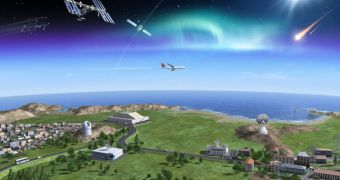The Space Situational Awareness (SSA) Preparatory Program that the European Space Agency (ESA) proposed as a means to protecting European space assets from destruction has recently been recognized by the European Commission, which agreed to fund the endeavor.
A short while ago, the Commission drew out the main space priorities the European Union should pursue, and the new Program is chiefly recognized among them. Analysts refer to it as a cornerstone of Europe's future in space.
The SSA is also defined as a strategic necessity, one that would help protect European assets in space, including advanced satellites – such as the future Galileo navigation system – and the International Space Station (ISS).
This necessity was highlighted in a report called “Towards a space strategy for the European Union that benefits its citizens,” which the Commission released back in April. It acknowledged the progresses made by the SSA Preparatory Program, since preparations began in January 2009.
According to ESA, the main goal of the Program is to detect hazards to critical satellites and infrastructure on the ground, and to do so with maximum efficiency. The most likely targets are space debris and junk, pieces of spent rocket stages and old satellites that are clogging Earth's orbit.
A full-scale complement of telescopes, radars and data processing centers is required to gather, process and centralize all of the necessary aspects of such a defense grid, and Europe currently has none of these capabilities. The SSA represents a sustained effort of eliminating this weakness.
When it is brought online, the defense network will also be able to warm about potential strikes on Earth, that may be caused by wandering space objects such as asteroids and comets. Our planet is not safe from such events, and knowing of the threat ahead of time means solving half the problem.
“There is strong agreement at national and European levels that we need services based on European assets that help us to protect our satellites and ground infrastructure against threats from orbital debris, space weather or possible impacts,” Nicolas Bobrinsky explains.
The official is the head of the ESA SSA Program Office. As part of the Preparatory Program, the ESA European Space Astronomy Center in Spain will be converted as an early warning facility later this year. Satellite operators will be the main beneficiaries of the new datasets.
“The [new] plan will show how existing European research capabilities, such as the scanning radar at the Fraunhofer Institute near Bonn or ESA's own Optical Ground Station on the Spanish island of Tenerife, can be efficiently integrated into the system,” says Bobrinsky.
“It will also specify the new sensors that must be built in order to secure Europe's autonomy,” he concludes.

 14 DAY TRIAL //
14 DAY TRIAL //